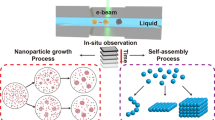Abstract
Ion-induced nucleation has been suggested to be a potentially important mechanism for atmospheric aerosol formation. Ions are formed in the background atmosphere by galactic cosmic rays. A possible connection between galactic cosmic rays and cloudiness has been However, the predictions of current atmospheric nucleation models are highly uncertain because the models are usually based on the liquid drop model that estimates cluster thermodynamics based on bulk properties (e.g., liquid drop density and surface tension). Sulfuric acid (H2SO4) and water are assumed to be the most important nucleating agents in the free troposphere. Measurements of the molecular thermodynamics for the growth and evaporation of cluster ions containing H2SO4 and H2O were performed using a temperature-controlled laminar flow reactor coupled to a linear quadrupole mass spectrometer as well as a temperature-controlled ion trap mass spectrometer. The measurements were complemented by quantum chemical calculations of the cluster ion structures. The analysis yielded a complete set of H2SO4 and H2O binding thermodynamics extending from molecular cluster ions to the bulk, based on experimental thermodynamics for the small clusters. The data were incorporated into a kinetic aerosol model to yield quantitative predictions of the rate of ion-induced nucleation for atmospheric conditions. The model predicts that the negative ion-H2SO4-H2O nucleation mechanism is an efficient source of new particles in the middle and upper troposphere.
Similar content being viewed by others
References
Arnold, F.: 1980, ‘Multi-ion complexes in the stratosphere – implications for trace gases and aerosol’, Nature 284, 610–611.
Ball, S. M., Hanson, D. R., and Eisele, F. L.: 1999, ‘Laboratory studies of particle nucleation: Initial results for H2SO4, H2O, and NH3 vapors’, J. Geophys. Res. 104, 23, 709–23, 718.
Bonn, B. and Moortgart, G. K.: 2003, ‘Sesquiterpene ozonolysis: Origin of atmospheric new particle formation from biogenic hydrocarbons’, Geophys. Res. Lett. 30, 10.1029/2003GL017000.
Carslaw, K. S., Harrison, R. G., and Kirby, J.: 2002, ‘Cosmic Rays, Clouds, and Climate’, Science 298, 1732–1737.
Clarke, A. D., Varner, J. L., Eisele, F., Mauldin, R. L., Tanner, D., and Litchy, M.: 1998, ‘Particle production in the remote marine atmosphere: Cloud outflow and subsidence during ACE 1, J. Geophys. Res. 103, 16,397–16,409.
Curtius, J., Froyd, K. D., and Lovejoy, E. R.: 2001, ‘Cluster ion thermal decomposition (I): Experimental kinetics study and ab intio calculations for HSO4 −(H2SO4)x(HNO3)y’, J. Phys. Chem. A 105, 10,867–10,873.
Eichkorn, S., Wilhelm, S., Aufmhoff, H., Wohlfrom, K. H., and Arnold, F.: 2002, ‘Cosmic ray-induced aerosol-formation: First observational evidence from aircraft-based ion mass spectrometer measurements in the upper troposphere’, Geophys. Res. Lett. 29, 10.1029/2002GL015044.
Froyd, K. D., and Lovejoy, E. R.: 2003, ‘Experimental thermodynamics of cluster ions composed of H2SO4 and H2O. 2. Negative ion measurements and ab initio structures’, J. Phys. Chem. A 107, 9812–9824.
Kazil, J., and Lovejoy, E. R.: 2004, ‘Tropospheric ionization and aerosol production: A model study’, J. Geophys. Res. 109, 10.1029/2004JD004852.
Kulmala, M., Vehkamäki, H., Petäjä, T., Dal Maso, M., Lauri, A., Kerminen, V.-M., Birmili, W., and McMurry, P. H.: 2004, ‘Formation and growth rates of ultrafine atmospheric particles: A review of observations’, J. Aerosol Sci. 35, 143–176, 10.1016/j.jaerosci.2003.10.003.
Laaksonen, A., Talanquer, V., and Oxtoby, D. W.: 1995, ‘Nucleation: Measurements, theory, and Atmospheric Applications’, Ann. Rev. Phys. Chem. 46, 489–524.
Lovejoy, E. R., and Curtius, J.: 2001, ‘Cluster ion thermal decomposition (II): Master equation modeling in the low pressure limit and fall-off regions. Bond Energies for HSO4 −(H2SO4)x (HNO3)y’, J. Phys. Chem. A 105, 10, 874–10, 883.
Lovejoy, E. R., Curtius, J., Froyd, K. D.: 2004, ‘Atmospheric ion-induced nucleation of sulphuric acid and water’, J. Geophys. Res. 109, 10.1029/2003JD004460.
Marsh, N. D., and Svensmark, H.: 2000, ‘Low cloud properties influenced by cosmic rays’, Phys. Rev. Lett. 85, 5004–5007.
O'Dowd, C. D., Jimenez, J. L., Bahreini, R., Flagan, R. C., Seinfeld, J. H., Hämeri, K., Pirjola, L., Kulmala, M., Jennings, S. G., and Hoffmann, T.: 2002, ‘Marine aerosol formation from biogenic iodine emissions’, Nature 417, 632–636, 10.1038/nature00775.
Rosen, J. M., Hofmann, D. J., and Gringel, W.: 1985, ‘Measurements of ion mobility to 30 km’, J. Geophys. Res. 90, 5876–5884.
Weber, R. J., McMurry, P. H., Mauldin III, R. L., Tanner, D. J., Eisele, F. L., Clarke, A. D., and Kapustin, V. N.: 1999, ‘New particle formation in the remote troposphere: A comparison of observations at various sites’, Geophys. Res. Lett. 26, 307–310.
Wyzlozil, B. E., Seinfeld, J. H., Flagan, R. C., and Okuyama, K.: 1991, ‘Binary nucleation in acid-water systems. II. Sulfuric acid-water and a comparison with methanesulfonic acid-water’, J. Chem. Phys. 94, 6842–6850.
Yu, F.: 2002, ‘Altitude variations of cosmic ray induced production of aerosols: Implications for global cloudiness and climate’, J. Geophys. Res. 107, 10.1029/2001JA000248.
Yu, F., and Turco, R. P.: 2001, ‘From molecular clusters to nanoparticles: Role of ambient ionization in tropospheric aerosol formation’, J. Geophys. Res. 106, 4797–4814.
Author information
Authors and Affiliations
Corresponding author
About this article
Cite this article
Curtius, J., Lovejoy, E.R. & Froyd, K.D. Atmospheric Ion-induced Aerosol Nucleation. Space Sci Rev 125, 159–167 (2006). https://doi.org/10.1007/s11214-006-9054-5
Received:
Accepted:
Published:
Issue Date:
DOI: https://doi.org/10.1007/s11214-006-9054-5




